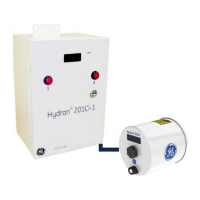4. Ensure:
• The System state indicator LED OK (item 25 in Figure 3-7) is off.
• The NO contact of the fail alarm is open.
• The NC contact of the fail alarm is closed.
• If connected, the SCADA system has detected the alarm.
7.2.4.4 Cancelling the Fail Alarm
1. Set the same parameter RelayMode to Normal.
2. Ensure:
• The System state indicator LED OK (item 25 in Figure 3-7) is lit.
• The NO contact of the fail alarm is closed.
• The NC contact of the fail alarm is open.
• If connected, the SCADA system has detected the state change of the fail
alarm relay.
7.2.4.5 Cancelling the Gas Alarms
1. Access the submenu Relays/Analog;GasH Relay.
2. Set this relay’s parameter RelayMode to Normal.
3. Access the submenu Relays/Analog;GasHH Relay.
4. Set this relay’s parameter RelayMode to Normal.
5. Ensure:
• The High alarm state LED H (item 27 in Figure 3-7) is off.
• The High-High alarm state LED HH (item 26 in Figure 3-7) is off.
• The System state indicator LED OK (item 25 in Figure 3-7) is lit.
• The NO contact of the High alarm is open.
• The NC contact of the High alarm is closed.
• The NO contact of the High-High alarm is open.
• The NC contact of the High-High alarm is closed.
• The NO contact of the fail alarm is closed.
• The NC contact of the fail alarm is open.
• If connected, the SCADA system has detected the state change of both gas
alarm relays.
7.2.4.6 Conclusion
1. If necessary, set the parameter RelayMode of each alarm relay to their initial
mode.
2. When all three relays have been tested, push END.
3. To abort an operation if needed, push ESC.
7.2.5 Verifying the Backup Battery
1. Access the top of the extended menu by pushing ENTER twice (History appears).
Note: Once accessed, the extended menu times out after 30 minutes of keypad
inactivity.

